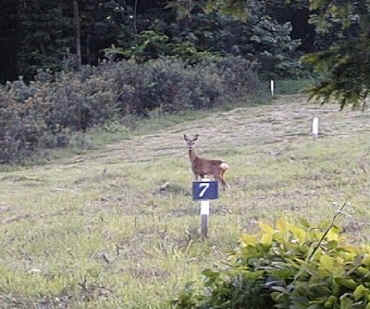|
The Woodland Education Centre |
|
|
The Woodland Education Centre |
|
Grazing Animals
 |
Tree seedlings, grasses and
bracken will all be controlled to some extent by the effect of grazing animals. Domestic
animals are not grazed on the site, but Roe Deer and rabbits are present.Roe Deer have been seen
grazing on the project site, but neither the extent of their grazing, nor their regional
preferences are known. They generally occur singly, or in small family groups rather than
in herds, so will have less effect than a herd animal such as Red Deer.
left: Roe doe on the Heathland Restoration site. |
| The Roe Deer frequently lie up in the control section in the day since the vegetation in this section has now grown up enough to provide an effective shield. Their feeding preferences include the buds and leaves of deciduous trees and shrubs, brambles, ivy , herbs, conifers, fern, heather and grasses. The effects they may be having on the the structure and distribution of the plant community is unknown. In other heathland areas (such as Lincolnshire and East Anglia), rabbits have been shown to have a devastating effect on the vegetation, which only recovers when they are excluded by some form of fencing. Some grazing is beneficial in that it controls the spread of grasses and tree seedlings, but over-grazing can be very detrimental. Again it is not known in what numbers the rabbits occur on the site, nor the effects they may be having. However, their numbers are clearly not excessive and it is unlikely that they are having a major detrimental effect. Heather (Calluna), fine grasses such as Agrostis spp., Bell Heather and seedling Gorse are at the top of their feeding preferences on heathland sites (Chadwick). It must be noted that most of the management techniques used on the project site to prevent the succession to woodland are non-selective, reducing all vegetation down to the same level. Grazing by animals, whether domestic or wild, is selective as illustrated above and will therefore affect the vegetation of a site significantly differently to brushcutting.
Other Animals The fauna on the heathland site has not yet been either qualitatively, or quantitatively surveyed. However, a number of animals have been seen while carrying out the annual vegetation surveys Tiger Beetles (Cicindela campestris) which are very characteristic heathland inhabitants, have occurred on the project site since 1996. Orthopterans (grasshoppers / crickets) were abundant in the grasses in the summer. Numerous spiders and several species of butterflies and dragonflies were commonly seen. Detailed qualitative and quantitative surveys of the fauna of the project site are planned for the future. |
|
Continue to project conclusions![]()
Ecological Surveys 96 - 98 |